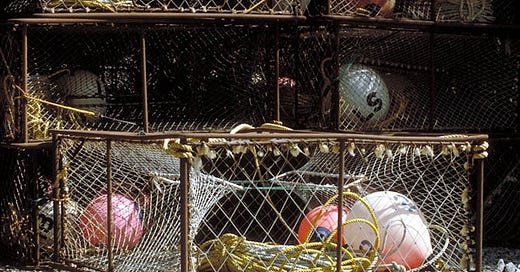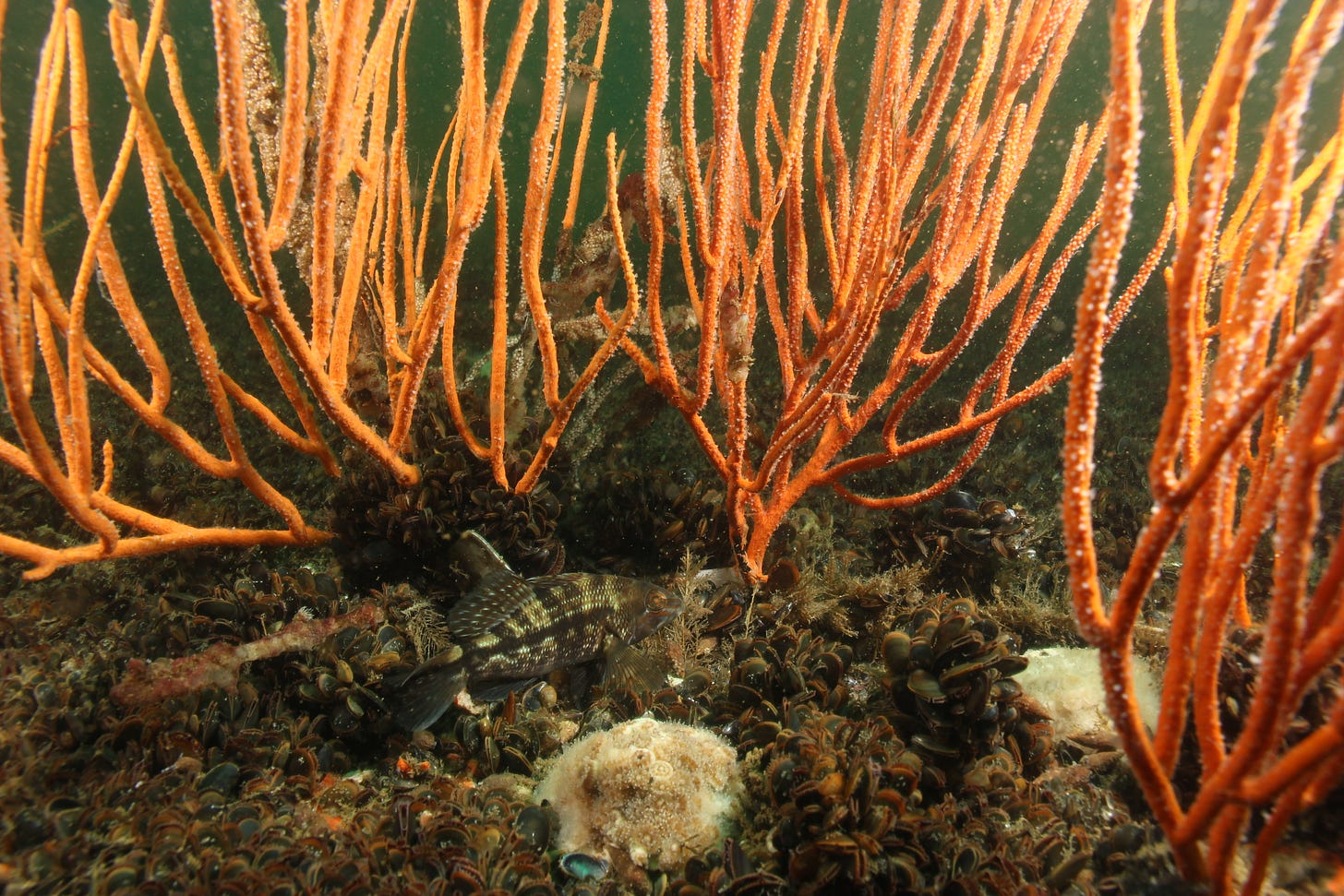#2. The Trouble with Traps - Part 1
In which the E@L exposes the dirty secrets of trap fishermen
Over the millennia that humans have been catching fish, we have developed devastatingly efficient mechanisms for achieving that goal. So efficient, in fact, that many populations of targeted marine species have been decimated by our actions. The detrimental impacts of fishing have been recognized for over a century, but only in the last few decades has our emphasis shifted from catching more fish to doing so in a sustainable manner that doesn’t harm the ecosystem. Reducing the impacts of fishing on the marine environment has become a primary goal of the National Oceanic and Atmospheric Administration (NOAA) [Disclaimer: the E@L was a Fishery Research Biologist for NOAA for 22 years]. This is somewhat ironic because one of the reasons for establishing NOAA within the Department of Commerce in 1970 was specifically to expand and enhance fishing opportunities. The name given to NOAA’s new mission is “Ecosystem-based fisheries management”, defined as a method to obtain sustainable benefits without harming populations, the environment, or ecosystem. In effect, it would shift the burden of proof and require that fishing be prohibited unless it can be proven not to be ecologically harmful. If effectively implemented, it would be a fundamental revolution in managing our use of the oceans.
Within this new paradigm, various types of fishing gear have come under scrutiny. Most notably, mobile fishing gear such as trawls have borne the brunt of the blame for ecosystem damage for two reasons: they catch virtually everything in their path (except those organisms that can escape or avoid it), and if they touch the bottom, they wreak havoc by damaging seafloor organisms, especially corals and other “emergent epifauna” that stand erect from the seafloor.
Traps, though, have long been thought to be more-or-less harmless in this regard. Most have been designed to take advantage of the behavior of specific organisms, luring them either with bait or the offer of refuge, in order to capture them alive. As Shakespeare so aptly put it, “Some Cupid kills with arrows, some with traps”. Because traps are extremely species-selective, they generally avoid the bycatch problems of other fisheries. They are also assumed to be stationary, and by having a small footprint, avoid the damage caused by mobile fishing gear.
As it turns out, though, that second assumption is wrong. Some traps do remain stationary because they are attached to the seafloor, such as set nets and fyke nets, so I exclude them from this discussion. But traps that can be moved, also known as pots, are another matter entirely. Traps are one of the most commonly used types of fishing gear for crabs, lobsters, shrimp, crayfish, fish, whelks, and conchs. Fishermen set them by the hundreds or thousands. “Fishing” them entails setting them with bait, waiting for catch to occur (usually days), then retrieving them, removing the catch, and resetting them.
Alaskan king crab trap (B. Stevens)
Black sea bass trap (B. Stevens)
The trouble with traps is that 1) they aren’t completely stationary, and 2) they require buoy lines to be recovered. Traps can and do move, when they are recovered by fishermen, or when they are dragged by boats, ice, or storms. And buoy lines are notorious for entangling marine mammals, primarily whales. In this two-part article, I will address both of those issues, starting with seafloor impacts. Much of the information in this discussion is derived from a review of trap fishing impacts I published in 2021.
Trap fishing has direct impacts on two major systems: captured species and the environment. Captured species include both targeted species and bycatch, but the impacts on both are mediated through mortality and reduction in abundance, which has downstream effects on genetic selection, reproduction, growth, feeding, and predator-prey dynamics. These are widely known, and not the topic of my discussion.
Loss of traps is another well-known phenomenon that has its own realm of study. Fishermen often lose 10-25% or more of their traps annually. During hurricanes, loss of lobster traps in the Florida Keys can exceed 50%. Derelict traps may become “ghost pots” that continue to catch unwary organisms, which then die and become bait for others. This process, called “ghost fishing” can continue for many years, leading to well documented losses of organisms and economic value. Many studies have documented these losses, and some coastal states have instigated recovery programs to remove lost traps from the environment. In most cases, though, the funding and effort required cannot keep up with loss rates. One such program in Virginia recovered over 32,000 blue crab traps in four years, but it was only a fraction of the 100,000 traps estimated to be lost annually in that area. Other efforts to recover derelict lobster traps in the Florida Keys also could not demonstrate any reduction in accumulation rates.
“Ghost trap” from Alaskan Tanner crab fishery (B. Stevens)
Environmental impacts of trap fishing have not been widely studied but fall into two categories: Biological impacts on non-captured organisms in the benthic (seafloor) and pelagic (swimming) environments, and physical impacts on seafloor structures.
The importance of structure for benthic organisms cannot be understated. Structure can be provided by physical objects such as rocks, shells, and gravel. But more often, it is provided by other organisms that are considered “emergent epifauna”. These include corals, seagrasses, oyster and mussel beds, tube-worm colonies, hydroids, bryozoans, tunicates, sea stars, and sea urchins.
Many organisms require complex structured habitats in which to live during parts of their lives. Juvenile blue crabs require seagrass beds; juvenile king crabs require hydroid and bryozoan colonies during their first year of life. In the Gulf of Alaska, adult king crabs have been observed (from submersibles) mating beneath canopies of soft corals, and I have even observed them on the surface of large funnel-shaped sponges. Alaskan rockfish (Sebastes spp), and black seabass Centropristis striata on the US east coast, spend most of their lives hovering around and beneath overhanging soft corals, which provide them protection from predators, and refugia for mating. In Alaskan waters, the tentacle umbrella canopies formed by large pink anemones Cribrinopsis fernaldi serve as shelter for Tanner crabs Chionoecetes bairdi and several species of caridean shrimps.
Juvenile black sea bass sheltering among sea whip corals off Maryland (B. Stevens)
As a biologist working on fishing boats, I’ve learned that fishermen have a lot of fixed beliefs, only some of which are correct. For example, fishermen believe that when they retrieve a trap using a hydraulic winch, it comes straight up off the seafloor. But observations that we made with trap-mounted cameras have shown that traps are actually dragged along the seafloor before they are lifted vertically off bottom. Many lobster and crab traps are fished singly, one buoy and line per trap. But in many fisheries, especially those for black sea bass or red deep-sea crabs, traps are connected together in long lines, with only a single buoy at each end. When those lines are retrieved, the traps at the near end of the line come up fairly quickly, and may be dragged for only a few seconds, because the boat is stationed almost directly over them. But traps farther down the line may be dragged for several minutes, pulled along the seafloor as closer traps are being retrieved. In shallow water fisheries, such as that for black sea bass, lines of 20 traps are set in 100-150 m or water, and trap lines may be only a few hundred meters long, so the dragging effect is minimized. But red deep-sea crabs are fished in waters over 2000 feet deep, and pot lines can be over a mile long, with 50-60 traps on them.
Trap fishing for red deep-sea crabs (B. Stevens)
The greatest potential for damage occurs where traps are set in rocky habitats that are home to corals, sponges, sea whips, crinoids and many other large emergent epifauna. Setting and recovering traps in such locations can cause them to be dragged like a plough, damaging emergent epifauna, and creating bare patches on the seafloor.
The most commonly cited recipients of trap damage are soft corals, stony corals, and sponges, followed by other motile epifauna and vegetation. Yet seagrass habitats are most likely to suffer the greatest impact from trap damage. This is often caused by traps moving around within a seagrass bed as a result of wave action or storms.
The initial footprint of a trap is small, typically less than one square meter, so the effect of individual traps landing on sensitive habitats is limited. In the Norway lobster fishery, less than 2.5% of traps landed on emergent epifauna (sea pens). Our studies showed that less than 5% of traps set for black sea bass landed on top of emergent epifauna when set. But movement during retrieval or storms enlarges this footprint significantly. Over 50% of black sea bass traps encountered epifauna during retrieval, thus increasing their impact by an order of magnitude. Lobster traps can be dragged hundreds of meters by storms. The collective footprint is magnified by the presence of hundreds or thousands of traps and repeated setting of traps in the same places over many years. These impacts are not randomly distributed but are concentrated in those habitats that contain sensitive emergent epifauna specifically because they support the targeted species.
Black sea bass fishermen have told us that they no longer fish in certain areas because they are no longer productive. We examined gorgonian sea whip corals Leptogorgia virgulata off the coast of Maryland with either a remotely operated vehicle (ROV) or via scuba diver and cameras. In areas fished commercially (i.e. with traps), over 37% of the surface area of sea whips was abraded or overgrown (which is indicative of damage because gorgonians produce toxins to ward off epibiotic growth). In areas subject to only recreational (e.g. hook and line) fishing, but not trap fishing, we observed damage to only 15% of gorgonian surfaces. Thus, it’s possible that trap fishing had caused damage to corals, which led to them being less productive areas for fish.
Some habitats can recover from trap-induced damage. Seagrasses affected by blue crab or Dungeness crab traps can recover within a year. Soft corals take much longer. In coastal areas of the US east coast sea whips can live for 10-20 years, and may have successful reproduction only at decadal intervals, so when damaged by fish traps, may take decades to recover. Deep water gorgonians can live for hundreds of years, so it can take just as long for them to recover. Colonies of Lophelia pertusa off the coast of North Carolina can be hundreds of years old and individual reefs may have accumulated over 50,000 years. But even where habitats can heal themselves, complete recovery may take many decades or may never fully occur. Ecosystems recovering from disturbance typically undergo permanent losses of 50% of organisms and 30% of diversity, thus suffering from a “recovery debt” that is never fully repaid.
Section of 9-year-old sea whip coral with age rings marked (total diameter about 1.5 mm) (B. Stevens)
To date, published research on the impacts of fish or shellfish traps on benthic environments has resulted in no substantial changes in their design or operation. In Part 2 of this article I will address the impacts of trap lines on whale entanglement, which has received much more attention, and is now driving the evolution of trap design in a new direction.









